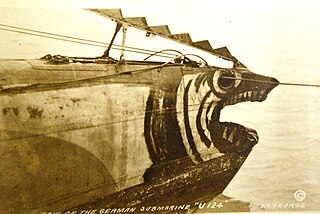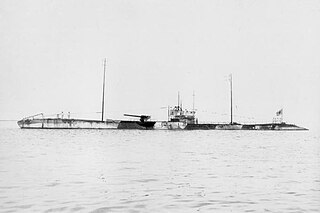SM U-83 was a Type U 81 U-boat of the German Imperial Navy during the First World War. She had been commissioned and deployed to operate off the coast of the British Isles and attack coastal shipping as part of the German U-boat campaign.

SM U-86 was a Type U 81 submarine manufactured in the Germaniawerft, Kiel shipyard for the German Empire during World War I.
SM U-82 was a Type U 81 U-boat of the Imperial German Navy during World War I.
SM U-72 was one of 329 submarines serving in the Imperial German Navy in World War I. U-72 was engaged in the commerce war in First Battle of the Atlantic.
SM U-74 was a Type UE 1 submarine and one of the 329 submarines serving in the Imperial German Navy in World War I. U-74 was engaged in the naval warfare and took part in the First Battle of the Atlantic.
SM U-75 was one of the 329 submarines serving in the Imperial German Navy in World War I. U-75 was engaged in naval warfare and took part in the First Battle of the Atlantic. On her first mission, U-75 laid the mine that sank the cruiser HMS Hampshire during her voyage to Russia carrying British Secretary of State for War Lord Kitchener. The cruiser sank at 59°07′N03°24′W west of the Orkney Islands with nearly total loss of life in a force 9 gale.
SM U-76 was a Type UE 1 submarine and one of the 329 submarines serving in the Imperial German Navy in World War I. U-76 was engaged in the naval warfare and took part in the First Battle of the Atlantic.
SM U-80 was one of the 329 submarines serving in the Imperial German Navy in World War I. U-80 was engaged in the naval warfare and took part in the First Battle of the Atlantic.
SM U-81 was one of the 329 submarines serving in the Imperial German Navy in World War I. U-81 was engaged in naval warfare and took part in the First Battle of the Atlantic.
SM U-84 was one of the 329 submarines serving in the Imperial German Navy in World War I. U-84 was engaged in the naval warfare and took part in the First Battle of the Atlantic.
SM U-85 was one of the 329 submarines serving in the Imperial German Navy in World War I. U-85 was engaged in the naval warfare and took part in the First Battle of the Atlantic.
SM U-88 was a Type U 87 submarine built for the Imperial German Navy in World War I. U-88 was engaged in the naval warfare and took part in the First Battle of the Atlantic.
SM U-89 was one of the 329 submarines serving in the Imperial German Navy in World War I. U-89 was engaged in the naval warfare and took part in the First Battle of the Atlantic. On 12 February 1918, U-89 was rammed and sunk by HMS Roxburgh off Malin Head. There were no survivors.
SM U-107 was one of the 329 submarines serving in the Imperial German Navy in World War I. U-107 was engaged in the naval warfare and took part in the First Battle of the Atlantic.
SM U-120 was a Type UE II long-range minelayer submarine of the Imperial German Navy. She was built at Hamburg, Germany, by Aktiengesellschaft Vulcan and launched on 20 June 1918. She was commissioned in the Imperial German Navy on 31 August 1918 with Kapitänleutnant Hans von Mellenthin in command. She had a short-lived career, not being assigned to any flotillas, nor achieving any successful attacks on enemy shipping, before the end of the First World War. She was surrendered to Italy on 22 November 1918, and was broken up in April 1919 at La Spezia.
SM U-122 was a Type UE II long-range minelayer submarine of the Imperial German Navy during World War I. U-122 was engaged in naval warfare and took part in the First Battle of the Atlantic. U-122 succeeded in sinking one ship during her career for a total of 278 gross register tons (GRT).
SM U-123 was one of the 329 submarines serving in the Imperial German Navy in World War I. U-123 was engaged in the naval warfare and took part in the First Battle of the Atlantic.

SM U-124 was one of the 329 submarines serving in the Imperial German Navy in World War I. U-124 was engaged in the naval warfare and took part in the First Battle of the Atlantic under the command of Kapitänleutnant Rolf Carls.

SM U-125 was one of the 329 submarines serving in the Imperial German Navy in World War I. U-125 was engaged in the naval warfare and took part in the First Battle of the Atlantic.
SM U-126 was one of the 329 submarines serving in the Imperial German Navy in World War I. U-126 was engaged in the naval warfare and took part in the First Battle of the Atlantic.


